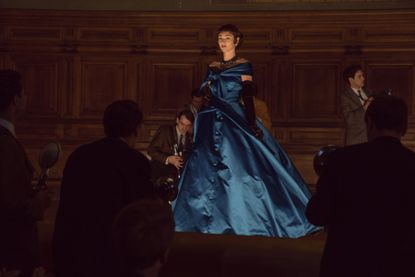In 1947, Christian Dior revolutionised the fashion industry with the launch of his eponymous fashion house and a captivating collection. The backdrop was Paris, recently liberated from Nazi occupation, and Dior himself had just broken free from Lucien Lelong's design house, where he had worked since 1942. Termed the 'New Look' by Carmel Snow, the influential editor-in-chief of Harper’s Bazaar, Dior's collection defied the austerity of the post-war era with its opulent designs. One standout piece, the iconic bar suit featuring an ivory, cinched-waist jacket paired with a full, pleated black skirt, quickly gained acclaim for its bold new silhouette. Now, inspired by Snow's apt descriptor, Apple TV+ presents "The New Look," a ten-part drama delving into the history of fashion, chronicling Dior's journey through World War II and the genesis of his groundbreaking style.
Karen Muller Serreau, the show's costume designer, recalls her grandmother's tales of Dior's iconic silhouette, which symbolized hope and progress. Created by Todd A. Kessler, the series introduces us to Dior (portrayed by Ben Mendelsohn) in 1955, as he prepares to address eager design students at the Sorbonne. However, an audience question transports us back to 1943, immersing us in the challenges of occupied Paris, a setting that would later infuse Dior's designs with profound significance. "I can understand its hopeful impact," reflects Muller Serreau. "As we recreated it, we felt the anticipation building, especially when we approached the unveiling of the bar suit. It was a moment of awe and relief, much like it must have been for people at that time, to see such elegance and abundance amidst hardship."
Karen Muller Serreau, the show's costume designer, recalls her grandmother's tales of Dior's iconic silhouette, which symbolized hope and progress. Created by Todd A. Kessler, the series introduces us to Dior (portrayed by Ben Mendelsohn) in 1955, as he prepares to address eager design students at the Sorbonne. However, an audience question transports us back to 1943, immersing us in the challenges of occupied Paris, a setting that would later infuse Dior's designs with profound significance. "I can understand its hopeful impact," reflects Muller Serreau. "As we recreated it, we felt the anticipation building, especially when we approached the unveiling of the bar suit. It was a moment of awe and relief, much like it must have been for people at that time, to see such elegance and abundance amidst hardship."

Running alongside Dior's narrative is the story of Coco Chanel, portrayed by Juliette Binoche. While Dior maneuvers through crafting party dresses for Nazi officers' wives to survive the war and worries about his sister Catherine (played by Maisie Williams), who is imprisoned for her involvement in the French Resistance, Chanel's tale unfolds quite differently. Despite purportedly closing her atelier in an act of patriotism, Chanel is depicted living at The Ritz, engaging in an affair with a Nazi agent. The rivalry between Dior and Chanel, along with the evolution of their fashion houses, forms the crux of "The New Look."
Costume designer Karen Muller Serreau found dressing Binoche and Williams' characters particularly enjoyable, although Chanel presented a unique challenge due to the scarcity of visual references from that period of her life. Muller Serreau aimed to capture Chanel's essence while avoiding stereotypical portrayals. Chanel's own fashion philosophy, such as her famous advice to remove one piece of jewellery before leaving the house, served as a guiding principle. Catherine's character, on the other hand, required a nuanced approach, transitioning from being Dior's sister and former model to a member of the resistance, necessitating a more subdued wardrobe to blend into the background.
The stark contrast between the glamour of the fashion world and the harsh reality of wartime was a recurring theme throughout production. Muller Serreau notes the intriguing juxtaposition between scenes of wartime austerity and the luxurious attire featured in Dior's debut fashion show. With only two scripts available at a time, the production team was constantly surprised by the unfolding storyline. "The New Look" offers viewers a glimpse into this captivating era, exploring themes of survival, rivalry, and the transformative power of fashion.

No comments:
Post a Comment